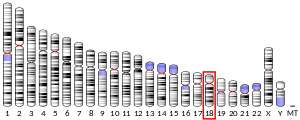RNF125
E3 ubiquitin-protein ligase RNF125 is an enzyme that in humans is encoded by the RNF125 gene.[3]
This gene encodes a novel E3 ubiquitin ligase that contains an N-terminal RING finger domain. The encoded protein may function as a positive regulator in the T-cell receptor signaling pathway.[3]
References
Further reading
- Giannini AL, Gao Y, Bijlmakers MJ (2008). "T-cell regulator RNF125/TRAC-1 belongs to a novel family of ubiquitin ligases with zinc fingers and a ubiquitin-binding domain". Biochem. J. 410 (1): 101–11. doi:10.1042/BJ20070995. PMC 2733222. PMID 17990982.
- Shoji-Kawata S, Zhong Q, Kameoka M, et al. (2007). "The RING finger ubiquitin ligase RNF125/TRAC-1 down-modulates HIV-1 replication in primary human peripheral blood mononuclear cells". Virology. 368 (1): 191–204. doi:10.1016/j.virol.2007.06.028. PMID 17643463.
- Zhao H, Li CC, Pardo J, et al. (2005). "A novel E3 ubiquitin ligase TRAC-1 positively regulates T cell activation". J. Immunol. 174 (9): 5288–97. doi:10.4049/jimmunol.174.9.5288. PMID 15843525.
- Gerhard DS, Wagner L, Feingold EA, et al. (2004). "The status, quality, and expansion of the NIH full-length cDNA project: the Mammalian Gene Collection (MGC)". Genome Res. 14 (10B): 2121–7. doi:10.1101/gr.2596504. PMC 528928. PMID 15489334.
- Ota T, Suzuki Y, Nishikawa T, et al. (2004). "Complete sequencing and characterization of 21,243 full-length human cDNAs". Nat. Genet. 36 (1): 40–5. doi:10.1038/ng1285. PMID 14702039.
- Chu P, Pardo J, Zhao H, et al. (2004). "Systematic identification of regulatory proteins critical for T-cell activation". J. Biol. 2 (3): 21. doi:10.1186/1475-4924-2-21. PMC 333404. PMID 12974981.
- Strausberg RL, Feingold EA, Grouse LH, et al. (2003). "Generation and initial analysis of more than 15,000 full-length human and mouse cDNA sequences". Proc. Natl. Acad. Sci. U.S.A. 99 (26): 16899–903. doi:10.1073/pnas.242603899. PMC 139241. PMID 12477932.
- Suzuki Y, Yoshitomo-Nakagawa K, Maruyama K, et al. (1997). "Construction and characterization of a full length-enriched and a 5'-end-enriched cDNA library". Gene. 200 (1–2): 149–56. doi:10.1016/S0378-1119(97)00411-3. PMID 9373149.
- Saurin AJ, Borden KL, Boddy MN, Freemont PS (1996). "Does this have a familiar RING?". Trends Biochem. Sci. 21 (6): 208–14. doi:10.1016/s0968-0004(96)80017-x. PMID 8744354.
- Maruyama K, Sugano S (1994). "Oligo-capping: a simple method to replace the cap structure of eukaryotic mRNAs with oligoribonucleotides". Gene. 138 (1–2): 171–4. doi:10.1016/0378-1119(94)90802-8. PMID 8125298.
This article is issued from
Wikipedia.
The text is licensed under Creative Commons - Attribution - Sharealike.
Additional terms may apply for the media files.


